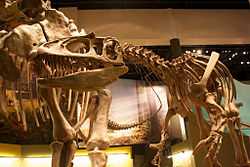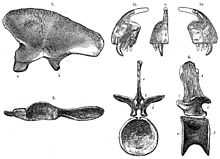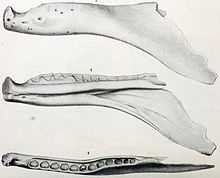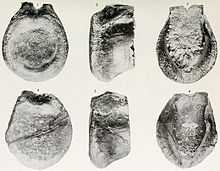Species of Allosaurus

There have been a number of potential species assigned to the carnosaurian dinosaur genus Allosaurus since its description in 1877 by Othniel Charles Marsh, but only a handful are still regarded as valid. Allosaurus was originally described from material from the Upper Jurassic Morrison Formation of the western United States of America; the type species A. fragilis became one of the best-known species of dinosaur.
The genus Allosaurus was part of the Marsh/Cope "Bone Wars" of the late 19th century, and its taxonomy became increasingly confused due to the competition, with several genera and species named by Cope and Marsh now regarded as synonyms of Allosaurus or A. fragilis. Since the description of Allosaurus, scientists have proposed additional species from such far-flung locales as Portugal, Siberia, Switzerland, and Tanzania, and unnamed remains from Australia and China have also been assigned to the genus at one time or another.
Query about type specimen

The issue of synonyms is complicated by the type specimen of Allosaurus fragillis (catalogue number YPM 1930) being extremely fragmentary, consisting of a few incomplete vertebrae, limb bone fragments, rib fragments, and a tooth. Because of this, several scientists have noted that the type specimen, and thus the genus Allosaurus itself or at least the species A. fragillis, is technically a nomen dubium ("dubious name", based on a specimen too incomplete to compare to other specimens or to classify). In an attempt to fix this situation, Gregory S. Paul and Kenneth Carpenter (2010) submitted a petition to the ICZN to have the name A. fragillis officially transferred to the more complete specimen USNM4734 (as a neotype). This request is currently pending review.[1]
Potentially valid species

It is unclear how many species of Allosaurus there were. Seven species have been considered potentially valid since 1988 (A. amplexus,[2] A. atrox,[2] A. europaeus,[3] the type species A. fragilis,[4] the as-yet not formally described "A. jimmadseni",[5] A. maximus,[6] and A. tendagurensis[4]), although only a fraction are usually considered valid at any given time. There are also at least ten dubious or undescribed species that have been assigned to Allosaurus over the years, along with the species belonging to genera now sunk into Allosaurus. In the most recent review of basal tetanuran theropods, only A. fragilis (including A. amplexus and A. atrox), "A. jimmadseni" (as an unnamed species), and A. tendagurensis were accepted as potentially valid species, with A. europaeus not yet proposed and A. maximus assigned to Saurophaganax.[4]
A. fragilis is the type species and was named by Marsh in 1877.[7] It is known from the remains of at least sixty individuals, all found in the Kimmeridgian–Tithonian Upper Jurassic-age Morrison Formation of the United States, spread across the states of Colorado, Montana, New Mexico, Oklahoma, South Dakota, Utah, and Wyoming.[4] Details of the humerus (upper arm) of A. fragilis have been used as diagnostic among Morrison theropods,[8] but the discovery of "A. jimmadseni" indicates that this will no longer be the case at the species level.[5] A. fragilis has always been difficult to define on the basis of its fragmentary and limited holotype, and so authors have advanced different proposals for redefining the species on better material.[2][8]
A. amplexus was named by Gregory S. Paul for giant Morrison allosaur remains, and included in his conception Saurophagus maximus (later Saurophaganax).[2] A. amplexus was originally coined by Cope in 1878 as the type species of his new genus Epanterias,[9] and is based on what is now AMNH 5767, parts of three vertebrae, a coracoid, and a metatarsal.[10] Following Paul's work, this species has been accepted as a synonym of A. fragilis.[4]
Allosaurus material from Portugal was first reported in 1999 on the basis of MHNUL/AND.001, a partial skeleton including a quadrate, vertebrae, ribs, gastralia, chevrons, part of the hips, and hindlimbs. This specimen was assigned to A. fragilis,[11] but the subsequent discovery of a partial skull and neck (ML 415) near Lourinhã, in the Kimmeridgian-age Porto Novo Member of the Lourinhã Formation, spurred the naming of the new species A. europaeus. It differs from other species of Allosaurus in cranial details.[3] However, more material may show it to be A. fragilis, as originally described.[12]

Daniel Chure's work on Morrison allosaurid remains has been responsible, directly or indirectly, for "A. jimmadseni" and A. maximus. "A. jimmadseni" is the proposed name for a new species of Morrison allosaur, based on a nearly complete skeleton and skull.[5][13] A. sp. 2, as it is also known, differs from A. fragilis in several anatomical details including a jugal or cheekbone with a straight lower margin, and is also found only in the Salt Wash Member of the Morrison Formation, with A. fragilis only present in the higher Brushy Basin Member.[14] A. maximus was coined by David K. Smith for Chure's Saurophaganax maximus, a taxon created by Chure in 1995 for giant allosaurid remains from the Morrison of Oklahoma. These remains had been known as Saurophagus, but that name was already in use, leading Chure to propose a substitute.[15] Smith, in his 1998 analysis of variation, concluded that S. maximus was not different enough from Allosaurus to be a separate genus, but did warrant its own species, A. maximus.[6] This reassignment was rejected in the most recent review of basal tetanurans.[4] There is also an A. maximus in Paul (1988), but it is a typographical error for A. amplexus.[2]
Biological variation, A. atrox, and A. fragilis

The perception that there were two common Allosaurus species in the Morrison Formation was popularized in Gregory S. Paul's 1988 book Predatory Dinosaurs of the World. Paul proposed that A. fragilis had tall pointed horns and a slender build compared to a postulated second species A. atrox, and was not a different gender due to rarity.[2] Allosaurus atrox was originally named by Marsh in 1878 as the type species of its own genus, Creosaurus, and is based on YPM 1890, an assortment of bones including a couple of pieces of the skull, portions of nine tail vertebrae, two hip vertebrae, an illium, and ankle and foot bones.[16] Although the idea of two common Morrison allosaur species has had support in semi-technical and popular works,[17] it has generally been rejected in the technical literature.[4]
David K. Smith, examining Allosaurus fossils by quarry, found that the Cleveland Lloyd Dinosaur Quarry (Utah) specimens are generally smaller than those from Como Bluff (Wyoming) or Brigham Young University's Dry Mesa Quarry (Colorado), but the shapes of the bones themselves did not vary between the sites.[18] A later study by Smith incorporating Garden Park (Colorado) and Dinosaur National Monument (Utah) specimens found no justification for multiple species based on skeletal variation; skull variation was most common and was gradational, suggesting individual variation was responsible.[6] Further work on size-related variation again found no consistent differences, although the Dry Mesa material tended to clump together on the basis of the astragalus, an ankle bone.[19] Kenneth Carpenter, using skull elements from the Cleveland Lloyd site, found wide variation between individuals, calling into question previous species-level distinctions based such features as the shape of the horns, and the proposed differentiation of "A. jimmadseni" based on the shape of the jugal.[20]
Invalid and synonymous species

A number of species assigned to Allosaurus are no longer recognized as valid, for one reason or another. Species "A. agilis", seen in Zittel, 1887, and Osborn, 1912, is a typographical error for A. fragilis.[5] Marsh's A. ferox (1896; not to be confused with his 1884 Labrosaurus ferox, also part of Allosaurus taxonomy) was coined for a partial skull in a footnote,[21] and has been recognized as a specimen of A fragilis.[4] A. lucaris, another Marsh name, was given to a partial skeleton in 1878.[16] He later decided it warranted its own genus, Labrosaurus,[22] but this has not been accepted, and A. lucaris is also regarded as another specimen of A. fragilis.[4] "A. whitei", an informally described species coined by Pickering in 1996, is a recasting of the A. atrox versus A. fragilis debate using a better specimen to represent the A. atrox form,[5] and has not been recognized.[4]

Several species coined in genera other than Allosaurus are also now thought to be synonymous with A. fragilis. Labrosaurus ferox was named in 1884 by Marsh for an oddly formed partial lower jaw, with a prominent gap in the tooth row at the tip of the jaw, and a rear section greatly expanded and turned down.[23] Later researchers suggested that the bone was pathologic, showing an injury to the living animal,[24] and that part of the unusual form of the rear of the bone was due to plaster reconstruction.[25] It is recognized as most likely a specimen of A. fragilis.[4][25] Allosaurus trihedrodon started as Laelaps trihedrodon, the name given to five theropod teeth by Cope in 1877.[26] Long lost but recently relocated, these specimens also appear to pertain to Allosaurus,[27] perhaps A. fragilis.[4] This species is also partly responsible for confusion surrounding Hypsirophus discursus, a species of stegosaurid named by Cope. Cope, who was considering Hypsirophus a theropod at the time, suggested that it might turn out to be the same as Laelaps trihedrodon.[27] Along with a mysterious theropod femur that he associated with Hypsirophus and which may have later been associated with Epanterias, this uncertainty has led to the misconception that Hypsirophus is a chimera,[27] based in part on Allosaurus fragilis remains.[4][28] Allosaurus valens is a typo for Antrodemus valens accidentally used by Friedrich von Huene in 1932;[5] Antrodemus valens itself may also pertain to Allosaurus fragilis,[4] as Gilmore suggested in 1920.[24] Apatodon mirus, based on a scrap of vertebra Marsh first thought to be a mammalian jaw, may[28] or may not[4] be the same as Allosaurus.
Misassigned species
Several species initially classified within or referred to Allosaurus do not belong within the genus. A. medius was named by Marsh in 1888 for "various specimens" from the Early Cretaceous of Maryland,[29] although most of the remains were removed by Richard Swann Lull to the new ornithopod species Dryosaurus grandis, except for a tooth.[30] Gilmore considered the tooth nondiagnostic but transferred it to a new species, Dryptosaurus medius.[24] The referral was not accepted in the most recent review, and Allosaurus medius was simply listed as a dubious species of theropod.[4] Allosaurus sibiricus was described in 1914 by A. N. Riabinin on the basis of a bone, later identified as a partial fourth metatarsal, from the Early Cretaceous of Buryatia, Russia.[31] It was transferred to Chilantaisaurus in 1990.[32] This is not the only report of Allosaurus from Siberia, or Asia in general. Kurzanov and colleagues in 2003 designated six teeth from Siberia as Allosaurus sp. (meaning the authors found the specimens to be most like those of Allosaurus, but did not or could not assign a species).[33] Also, reports of Allosaurus in Shanxi, China go back to at least 1982,[34] and tail vertebrae from Datong in Shanxi have been assigned to A. sp.[35]
Allosaurus meriani was described in 1870 by Greppin as a species of Megalosaurus, based on a tooth from the Late Jurassic of Switzerland.[36] It has occasionally been referred to Allosaurus,[28] but recent reviews have listed it as dubious theropod species Megalosaurus meriani,[4] or included it in Ceratosaurus sp.[25] Allosaurus stechowi was described in 1920 by Janensch as Labrosaurus stechowi for isolated Ceratosaurus-like teeth from the Tendaguru beds of Tanzania.[37] With the synonymization of Labrosaurus and Allosaurus, Donald F. Glut listed it as a species of Allosaurus,[28] but it is now either assigned to Ceratosaurus sp.[25] or considered a dubious ceratosaurian.[38]
There are also several species left over from the synonymizations of Creosaurus and Labrosaurus with Allosaurus. Creosaurus potens was named by Lull in 1911 for a vertebra from the Early Cretaceous of Maryland.[30] It is now regarded as a dubious theropod.[4] "Labrosaurus huene" is an informal name used by von Huene (1956, 1958) for a tooth from the Late Jurassic of Szechuan, China, and L. fragilis is a typographical error by Marsh (1896) for Labrosaurus ferox.[25] L. sulcatus, named by Marsh in 1896 for a Morrison theropod tooth,[21] which like L. stechowi is now regarded as either Ceratosaurus sp.[25] or a dubious ceratosaurian.[38]

A. tendagurensis was named in 1925 by Werner Janensch for a partial shin (HM 67) found in the Kimmeridgian-age rocks of Tendaguru, in Mtwara, Tanzania.[39] This species has not had strong support in recent years, with opinions on its identity ranging from a tentatively valid species of Allosaurus,[4] to a basal tetanuran,[40] to simply a dubious theropod.[28] The most recent analysis has placed it in Carcharodontosauridae.[41] Although obscure, it was a large theropod, possibly around 10 meters long (33 ft) and 2.5 metric tons (2.8 short tons) in weight.[42]
Possible Australian Allosaurus
An astragalus (ankle bone) thought to belong to a species of Allosaurus was found at Cape Paterson, Victoria in Early Cretaceous beds in southeastern Australia. It was thought to provide evidence that Australia was a refugium for animals that had gone extinct elsewhere.[43] This identification was challenged by Samuel Welles, who thought it more resembled that of an ornithomimid,[44] but the original authors defended their identification.[45] With fifteen years of new specimens and research to look at, Daniel Chure reexamined the bone and found that it was not Allosaurus, but could represent an allosauroid.[46] Similarly, Yoichi Azuma and Phil Currie, in their description of the basal allosauroid Fukuiraptor, noted that the bone closely resembled that of their new genus.[47] This specimen is sometimes referred to as "Allosaurus robustus", an informal museum name.[13] It may have belonged to something similar to, or the same as, Australovenator,[48] or it may represent an abelisaur.[49] A speculative "polar" or "dwarf allosaur" was used for the "Spirits of the Ice Forest" episode of Walking with Dinosaurs.
References
- ↑ Paul, Gregory S.; and Carpenter, Kenneth (2010). "Allosaurus Marsh, 1877 (Dinosauria, Theropoda): proposed conservation of usage by designation of a neotype for its type species Allosaurus fragilis Marsh, 1877". Bulletin of Zoological Nomenclature 67 (1): 53–56.
- ↑ 2.0 2.1 2.2 2.3 2.4 2.5 Paul, Gregory S. (1988). "Genus Allosaurus". Predatory Dinosaurs of the World. New York: Simon & Schuster. pp. 307–313. ISBN 0-671-61946-2.
- ↑ 3.0 3.1 Mateus, Octávio; Walen, Aart; and Antunes, Miguel Telles (2006). "The large theropod fauna of the Lourinha Formation (Portugal) and its similarity to that of the Morrison Formation, with a description of a new species of Allosaurus". In Foster, John R.; and Lucas, Spencer G. (eds.). Paleontology and Geology of the Upper Jurassic Morrison Formation. New Mexico Museum of Natural History and Science Bulletin, 36. Albuquerque, New Mexico: New Mexico Museum of Natural History and Science. pp. 123–129.
- ↑ 4.0 4.1 4.2 4.3 4.4 4.5 4.6 4.7 4.8 4.9 4.10 4.11 4.12 4.13 4.14 4.15 4.16 4.17 4.18 Holtz, Thomas R., Jr.; Molnar, Ralph E.; and Currie, Philip J. (2004). Weishampel, David B.; Dodson, Peter; and Osmólska, Halszka (eds.), ed. The Dinosauria (2nd ed.). Berkeley: University of California Press. pp. 71–110. ISBN 0-520-24209-2.
- ↑ 5.0 5.1 5.2 5.3 5.4 5.5 Chure, Daniel J. (2000). A new species of Allosaurus from the Morrison Formation of Dinosaur National Monument (Utah–Colorado) and a revision of the theropod family Allosauridae. Ph.D. dissertation. Columbia University.
- ↑ 6.0 6.1 6.2 Smith, David K. (1998). "A morphometric analysis of Allosaurus". Journal of Vertebrate Paleontology 18 (1): 126–142. doi:10.1080/02724634.1998.10011039.
- ↑ Marsh, Othniel Charles (1877). "Notice of new dinosaurian reptiles from the Jurassic formation". American Journal of Science and Arts 14: 514–516.
- ↑ 8.0 8.1 Madsen, James H., Jr. (1993) [1976]. Allosaurus fragilis: A Revised Osteology. Utah Geological Survey Bulletin 109 (2nd ed.). Salt Lake City: Utah Geological Survey.
- ↑ Cope, Edward Drinker (1878). "A new opisthocoelous dinosaur". American Naturalist 12 (6): 406. doi:10.1086/272127.
- ↑ Osborn, Henry Fairfield; and Mook, Charles C. (1921). "Camarasaurus, Amphicoelias, and other sauropods of Cope". Memoirs of the American Museum of Natural History, New Series 3 (3): 247–387.
- ↑ Pérez-Moreno, B.P.; Chure, D.J.; Pires, C.; Silva, C.M.; Santos, V.; Dantas, P.; Póvoas, L.; Cachão, M.; Sanz, J.L.; and Galopim De Carvalho, A.M. (1999). "On the presence of Allosaurus fragilis (Theropoda: Carnosauria) in the Upper Jurassic of Portugal: First evidence of an intercontinental dinosaur species" (pdf). Journal of the Geological Society 156 (3): 449–452. doi:10.1144/gsjgs.156.3.0449.
- ↑ Malafaia, Elisabete; Dantas, Pedro; Ortega, Francisco; and Escaso, Fernando (2007). "Nuevos restos de Allosaurus fragilis (Theropoda: Carnosauria) del yacimiento de Andrés (Jurásico Superior; centro-oeste de Portugal)" (pdf). Cantera Paleontológica (in Spanish with English abstract): 255–271.
- ↑ 13.0 13.1 Glut, Donald F. (2003). "Allosaurus". Dinosaurs: The Encyclopedia. 3rd Supplement. Jefferson, North Carolina: McFarland & Co. pp. 221–233. ISBN 0-7864-1166-X.
- ↑ Loewen, Mark A.; Sampson, Scott D.; Carrano, Matthew T.; and Chure, Daniel J. (2003). "Morphology, taxonomy, and stratigraphy of Allosaurus from the Upper Jurassic Morrison Formation". Journal of Vertebrate Paleontology 23 (3, Suppl.): 72A.
- ↑ Chure, Daniel J. (1995). "A reassessment of the gigantic theropod Saurophagus maximus from the Morrison Formation (Upper Jurassic) of Oklahoma, USA". In Ailing Sun and Yuangqing Wang (eds.). Sixth Symposium on Mesozoic Terrestrial Ecosystems and Biota, Short Papers. Beijing: China Ocean Press. pp. 103–106. ISBN 7-5027-3898-3.
- ↑ 16.0 16.1 Marsh, Othniel Charles (1878). "Notice of new dinosaurian reptiles". American Journal of Science and Arts 15: 241–244.
- ↑ Lessem, Don; and Glut, Donald F. (1993). "Allosaurus". The Dinosaur Society's Dinosaur Encyclopedia. Random House. pp. 19–20. ISBN 0-679-41770-2.
- ↑ Smith, David K. (1996). "A discriminant analysis of Allosaurus population using quarries as the operational units". Museum of Northern Arizona Bulletin 60: 69–72.
- ↑ Smith, David K. (1999). "Patterns of size-related variation within Allosaurus". Journal of Vertebrate Paleontology 19 (2): 402–403. doi:10.1080/02724634.1999.10011153.
- ↑ Carpenter, Kenneth (2010). "Variation in a population of Theropoda (Dinosauria): Allosaurus from the Cleveland-Lloyd Quarry (Upper Jurassic), Utah, USA". Paleontological Research 14 (4): 250–259. doi:10.2517/1342-8144-14.4.250.
- ↑ 21.0 21.1 Marsh, Othniel Charles (1896). "The dinosaurs of North America". United States Geological Survey, 16th Annual Report, 1894–95 55: 133–244.
- ↑ Marsh, Othniel Charles (1879). "Principal characters of American Jurassic dinosaurs. Part II". American Journal of Science, Series 3 17: 86–92.
- ↑ Marsh, Othniel Charles (1884). "Principal characters of American Jurassic dinosaurs. Part VIII". American Journal of Science, Series 3 27: 329–340.
- ↑ 24.0 24.1 24.2 Gilmore, Charles W. (1920). "Osteology of the carnivorous dinosauria in the United States National Museum, with special reference to the genera Antrodemus (Allosaurus) and Ceratosaurus". Bulletin of the United States National Museum 110: 1–159.
- ↑ 25.0 25.1 25.2 25.3 25.4 25.5 Madsen, James H.; and Welles, Samuel P. Ceratosaurus (Dinosauria, Theropoda), a Revised Osteology. Miscellaneous Publication, 00-2. Utah Geological Survey. ISBN 1-55791-380-3.
- ↑ Cope, Edward Drinker (1877). "On a carnivorous dinosaurian from the Dakota Beds of Colorado". Bulletin of the United States Geological Survey 3 (33): 805–806.
- ↑ 27.0 27.1 27.2 Chure, Daniel J. (2001). "On the type and referred material of Laelaps trihedrodon Cope 1877 (Dinosauria: Theropoda)". In Tanke, Darren; and Carpenter, Kenneth (eds.). Mesozoic Vertebrate Life. Bloomington and Indianapolis: Indiana University Press. pp. 10–18. ISBN 0-253-33907-3.
- ↑ 28.0 28.1 28.2 28.3 28.4 Glut, Donald F. (1997). "Allosaurus". Dinosaurs: The Encyclopedia. Jefferson, North Carolina: McFarland & Co. pp. 105–117. ISBN 0-89950-917-7.
- ↑ Marsh, Othniel Charles (1888). "Notice of a new genus of Sauropoda and other new dinosaurs from the Potomac Formation". American Journal of Science, Series 3 35: 89–94.
- ↑ 30.0 30.1 Lull, Richard Swann (1911). "The Reptilia of the Arundel Formation". Maryland Geological Survey: Lower Cretaceous: 173–178.
- ↑ Riabinin, Anatoly Nikolaenvich (1914). "Zamtka o dinozavry ise Zabaykalya". Trudy Geologichyeskago Muszeyah Imeni Petra Velikago Imperatorskoy Academiy Nauk (in Russian) 8 (5): 133–140.
- ↑ Molnar, Ralph E.; Kurzanov, Sergei M.; and Dong Zhiming (1990). "Carnosauria". In Weishampel, David B.; Dodson, Peter; and Osmólska, Halszka (eds.). The Dinosauria (1st ed.). Berkeley: University of California Press. pp. 169–209. ISBN 0-520-06727-4.
- ↑ Kurzanov, Sergei S.; Efimov, Mikhail B.; and Gubin, Yuri M. (2003). "New archosaurs from the Jurassic of Siberia and Mongolia". Paleontological Journal 37 (1): 53–57.
- ↑ Glut, Donald F. (1982). The New Dinosaur Dictionary. Secaucus, NJ: Citadel Press. p. 44. ISBN 0-8065-0782-9.
- ↑ Lü, Junchang; and Hu, P. (1998). "Dinosaur remains from Datong suburb, Shanxi Province". Vertebrata PalAsiatica 36 (3): 252–256.
- ↑ Greppin, J.B. (1870). "Description geologique du Jura bernois et de quelques districts adjacents". Beiträge zur geologischen Karte der Schweiz (in French) 8: 1–357.
- ↑ Janensch, Werner (1920). "Uber Elaphrosaurus bambergi und die Megalosaurier aus den Tendaguru-Schichten Deutsch-Ostafricas". Sitzungsberichte Gesellschaft Naturforschender Freunde Berlin 8: 225–235.
- ↑ 38.0 38.1 Tykoski, Ronald S.; and Rowe, Timothy. (2004). "Ceratosauria", in The Dinosauria (2nd). 47–70.
- ↑ Janensch, Werner (1925). "Die Coelurosaurier und Theropoden der Tendaguru-Schichten Deutsch-Ostafrikas". Palaeontographica, Supplement 7 (in German) 1: 1–99.
- ↑ Rauhut, Oliver W.M. (2005). "Post-cranial remains of 'coelurosaurs' (Dinosauria, Theropoda) from the Late Jurassic of Tanzania". Geological Magazine 142 (1): 97–107. doi:10.1017/S0016756804000330.
- ↑ Rauhut, Oliver W. M. (2011). "Theropod dinosaurs from the Late Jurassic of Tendaguru (Tanzania)". Special Papers in Palaeontology 86: 195–239. doi:10.1111/j.1475-4983.2011.01084.x.
- ↑ Mortimer, Mickey (2003-07-21). "And the Largest Theropod Is....". The Dinosaur Mailing List. Retrieved 2007-09-08.
- ↑ Molnar, Ralph E.; Flannery, Timothy F.; and Rich, Thomas H.V. (1981). "An allosaurid theropod dinosaur from the Early Cretaceous of Victoria, Australia". Alcheringa 5 (2): 141–146. doi:10.1080/03115518108565427.
- ↑ Welles, Samuel P. (1983). "Allosaurus (Saurischia, Theropoda) not yet in Australia". Journal of Paleontology 57 (2): 196.
- ↑ Molnar, Ralph E.; Flannery, Timothy F.; and Rich, Thomas H.V. (1985). "Aussie Allosaurus after all". Journal of Paleontology 59 (6): 1511–1535.
- ↑ Chure, Daniel J. (1998). "A reassessment of the Australian Allosaurus and its implications for the Australian refugium concept". Journal of Vertebrate Paleontology 18 (3, Suppl.): 34A.
- ↑ Azuma, Yoichi; and Currie, Philip J. (2000). "A new carnosaur (Dinosauria: Theropoda) from the Lower Cretaceous of Japan". Journal of Vertebrate Paleontology 37 (12): 1735–1753.
- ↑ Hocknull, Scott A.; White, Matt A.; Tischler, Travis R.; Cook, Alex G.; Calleja, Naomi D.; Sloan, Trish; and Elliott, David A. (2009). "New Mid-Cretaceous (Latest Albian) Dinosaurs from Winton, Queensland, Australia". In Sereno, Paul. PLoS ONE 4 (7): e6190. doi:10.1371/journal.pone.0006190. PMC 2703565. PMID 19584929.
- ↑ Agnolin, F. L.; Ezcurra, M. D.; Pais, D. F.; and Salisbury, S. W. (2010). "A reappraisal of the Cretaceous non-avian dinosaur faunas from Australia and New Zealand: Evidence for their Gondwanan affinities". Journal of Systematic Palaeontology 8 (2): 257–300. doi:10.1080/14772011003594870.